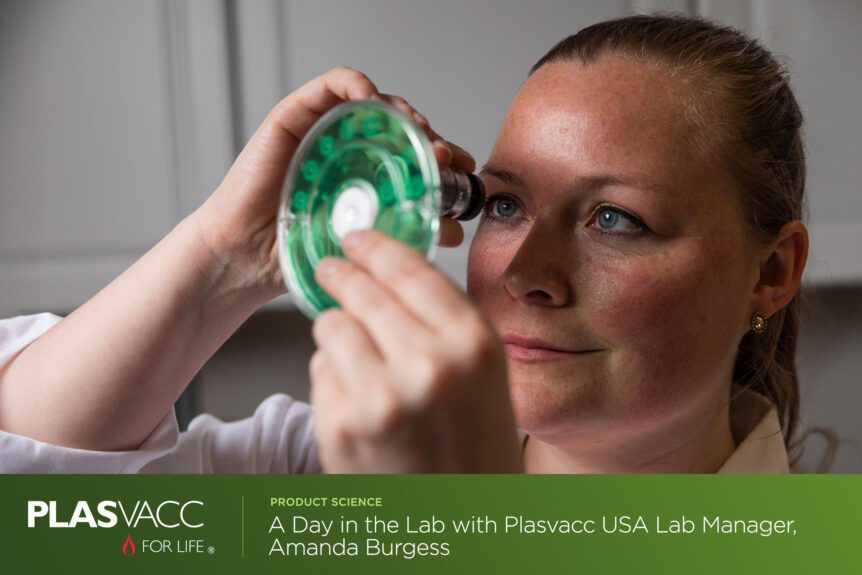Working to become the world standard in veterinary biologic plasma products over the past 30 years has been a long and rewarding journey for Plasvacc, but none of it would have been possible if not for the work done within our in-house laboratory.
Having a dedicated laboratory on-site at our Templeton, California headquarters allows Plasvacc USA to conduct vital research, development, and testing processes in a controlled and efficient environment. This facilitates our ability to innovate, create, and refine new products and treatments.
We recently sat down with Plasvacc USA Lab Manager, Amanda Burgess, to take a closer look at what led her to Plasvacc and what a day in the lab looks like:
What was the path that led you to Plasvacc?
I attended Cal Poly, San Luis Obispo, where I originally was pursuing a degree in Animal Science with an emphasis on Veterinary Medicine. Once I had the hard realization that I faint during surgeries, it was apparent that I needed to adjust my career choice. I’ve always been very science and tech-minded, so I decided to minor in biotechnology to broaden my horizons a bit. A few months after graduation, I found Plasvacc! It was the perfect mix for my specialties and interests—science with a companion-animal twist. I’ve been with Plasvacc ever since.
What does being the Laboratory Manager at Plasvacc entail?
As Plasvacc’s Laboratory Manager, I have quite a wide breadth of responsibilities. From overseeing the quality control testing performed on every single run of product, ensuring its safety, efficacy and potency to handling inquiries from regulating authorities, it all falls into my realm. I also have a hand in product development, research, and database development/maintenance.
What does a day in the lab look like?
This depends on the day and the project at hand! A typical day would include the quality control testing of the previous week’s plasma samples—so that means you could find me under the laminar flow hood performing sterility testing. On certain days, you’ll find me in the lab applying samples to a radial immunodiffusion (RID) plate for total IgG quantification or screening batches of plasma for efficacious antibody levels via ELISA [enzyme-linked immunosorbent assay] testing…and the list goes on! These quality control processes are the most important aspect of my job, as ensuring our plasma is as safe and effective as possible is what has allowed Plasvacc to become the benchmark for the plasma therapy market. I’m consistently amazed at the level of testing we can conduct on-site and the amount of control we have over the entire production process.
What is your favorite part of being Lab Manager?
One of the things I love most about my job is that I hardly ever have what you’d refer to as a “normal” day. New projects are constantly starting, and new areas where Plasvacc products can help the veterinary community are constantly being explored. I love the challenge of developing a vaccine, taking a closer look at the finer points of vaccination protocol, and developing test methods for new products-whether as a new USDA-licensed product for the entire US market or as an autogenous product for a specific ranch struggling with a pathogen that has no other treatment options. I truly feel like I make a difference with my work. [Ed. note: She does!]
Can you speak to the benefits provided by the capabilities of Plasvacc’s in-house lab?
Well, for starters, the Plasvacc lab adds many benefits for Plasvacc itself, but also for surrounding veterinarians in the area. Having such extensive lab capabilities in-house allows us to ensure the prompt, accurate testing of all batches of our plasma, meaning all quality control testing is able to be performed on-site following our USDA-approved protocols. This gives us full traceability for all testing results and the comfort of knowing each batch is tested exactly to our sky-high standards. We are also able to develop assays as necessary for testing autogenous or new plasma products to ensure their potency. We invest a significant number of resources into our lab, and our capabilities seem to grow by the month. Additionally, two technicians, including myself, are certified by the USDA’s National Veterinary Services Laboratory (NVSL) to perform Equine Infectious Anemia (EIA) testing (also known as “Coggins”) for both our own plasma and horses as well as for outside veterinarians.
How does the lab assist with research and development?
I’m a scientist at heart—and brain too! With the Plasvacc lab leading the charge on R&D efforts, I love that I’m able to put my passion to work in helping develop new products. Early-stage research is both a strength and a love of mine, so whenever we identify a new area of interest, I am always eager to jump in and contribute. The lab does the majority of literature searches and background information compilation for many new projects while I oversee the development of assays for new products to ensure their potency and safety for the consumer.
Do Plasvacc’s lab processes/methodology set it apart from competitors in any way or offer any specific advantages in regard to product efficacy/safety?
Every single batch of plasma undergoes very stringent quality control testing that has been evaluated and accepted by the USDA. We go above and beyond to ensure our products maintain their excellent safety rating (<0.001% reported reaction rate) through blood typing and screening our donors for agglutinating and hemolyzing antibodies. We pride ourselves on having top-shelf products, and our testing follows that. No serial is offered for sale to veterinarians that has not passed our intense testing regime—both for the quality of antibodies in the bag as well as for the safety of the animal receiving it. When it comes to efficacy, every batch is certified against a Master Reference that was proven efficacious or standards of known potency.

